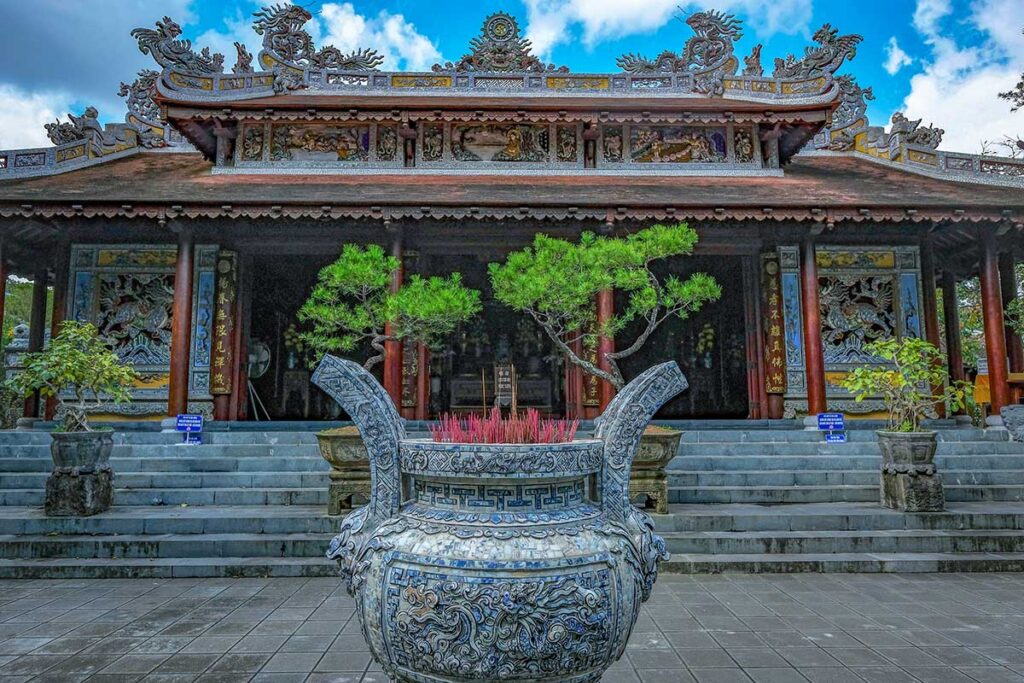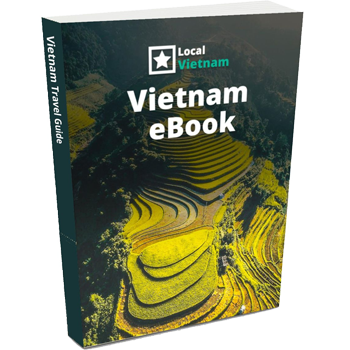What is Tu Hieu Pagoda?

Tu Hieu Pagoda is a peaceful Buddhist temple located in a quiet pine forest about 5 kilometers southwest of Hue’s city center. It’s best known as the pagoda where Zen master Thich Nhat Hanh began his spiritual training, and as the burial place of Nguyen Dynasty eunuchs, who supported the temple financially in the 19th century. Unlike some of Hue’s grander temples, Tu Hieu has a calm, humble atmosphere—making it a great spot for reflection, walking, and learning about the spiritual side of Vietnam’s history.
Who is Zen master Thich Nhat?
One of the most well-known figures associated with Tu Hieu Pagoda is Zen master Thich Nhat Hanh. Born in Hue in 1926, he became a novice monk here at the age of 16 and later rose to international prominence as a Buddhist teacher, peace activist, and author. Exiled during the Vietnam War for his anti-violence stance, he spent decades teaching mindfulness around the world before returning to Tu Hieu in 2018 to spend his final years. Today, many visitors come not only to see the pagoda, but to connect with the quiet legacy of Thich Nhat Hanh’s life and teachings.
History of Tu Hieu Pagoda
Tu Hieu Pagoda dates back to 1843, when it was founded by Zen master Nhat Dinh, a respected monk known for his simple lifestyle and deep compassion. At the time, Nhat Dinh was caring for his sick mother in the forest, and disciples helped him build a small temple to continue his spiritual practice while staying near her. This gesture of filial piety—honoring and caring for one’s parents—is part of what gives the pagoda its name. “Tu Hieu” roughly means “filial piety and compassion.”
Later, the temple became known for its connection to the royal eunuchs of the Nguyen Dynasty, who supported the expansion and upkeep of the pagoda in exchange for having a place to retire and be buried. Their tombs still remain on the grounds and give the temple a unique historical dimension.
Over the years, Tu Hieu has been renovated several times, including major restorations during the reign of Emperor Tu Duc and later in the 20th century. It has long served as a center of Zen Buddhist teaching and practice. Most notably, it is the root temple of Thich Nhat Hanh, the globally influential Vietnamese monk and peace activist. After decades of exile, he returned here in 2018 to spend his final years in quiet meditation before passing away in 2022.
Today, the pagoda continues to serve as both a monastery and a pilgrimage site, known for its peaceful forest setting and spiritual legacy.
Highlights & architecture
Unlike the towering pagodas and ornate shrines of Hue’s royal temples, Tu Hieu Pagoda is defined by its simplicity, natural setting, and spiritual atmosphere. The layout is compact, but the grounds are surrounded by pine trees, lotus ponds, and winding stone paths. The architecture reflects traditional Vietnamese temple design, with low wooden buildings, curved tile roofs, and soft colors that blend into the forest. Here are the highlights to look for as you explore:
1. Main gate and pine forest path
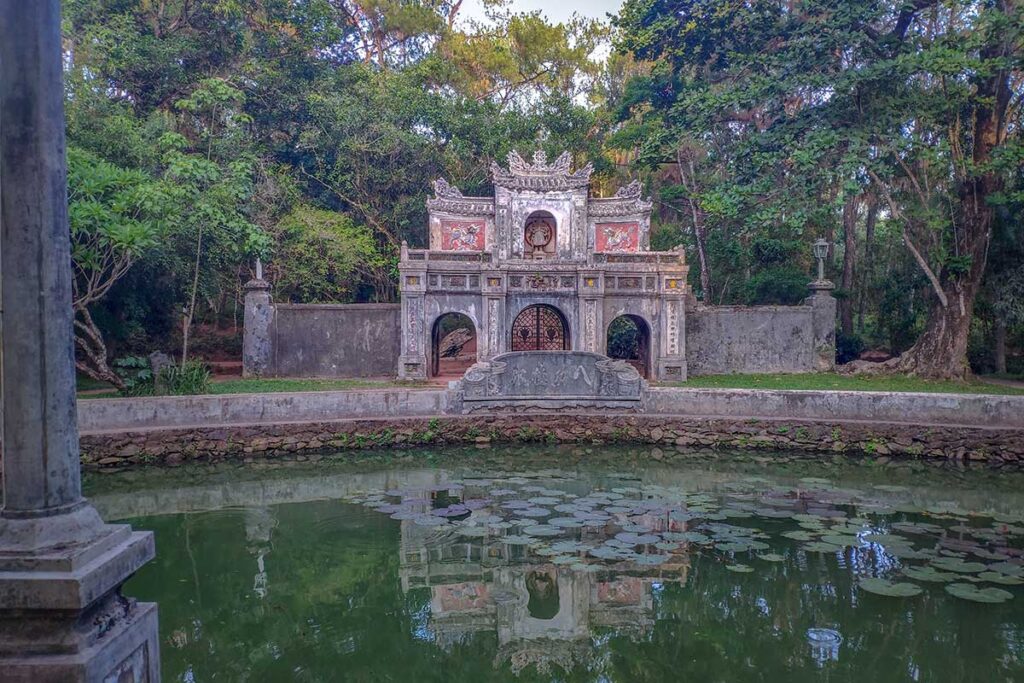
Your visit begins with a stone path through tall pine trees, leading to a simple arched gate that marks the entrance to the temple grounds. The quiet walk sets the tone—calm, natural, and far removed from the noise of the city.
2. Front courtyard and lotus pond
Just inside the gate, you’ll find a small lotus pond and open courtyard. The pond reflects the nearby trees and buildings, especially peaceful in the early morning. A few benches are scattered around, where visitors and monks sometimes sit in silence or gentle conversation.
3. Main Hall (Chanh Dien)

The central prayer hall is a modest, open-sided building made of dark wood, housing statues of the Three Buddhas along with ancestor tablets and offerings. Inside, you’ll often hear soft chanting or see monks engaged in quiet rituals. It’s not grand in size, but the atmosphere is deeply serene.
4. Tomb of Zen Master Nhat Dinh
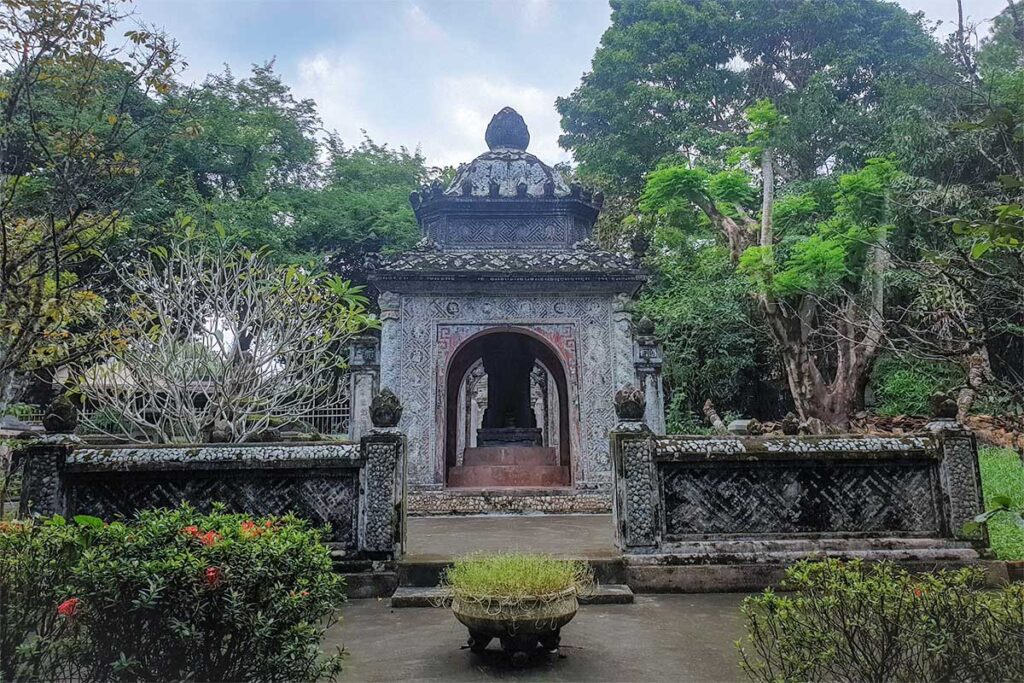
Behind the main hall stands the tomb of the temple’s founder, Zen master Nhat Dinh. It’s a simple stone structure shaded by trees, serving as a place of respect for visitors and monastics alike. His story is central to the pagoda’s identity and spirit.
5. Graves of the Royal Eunuchs

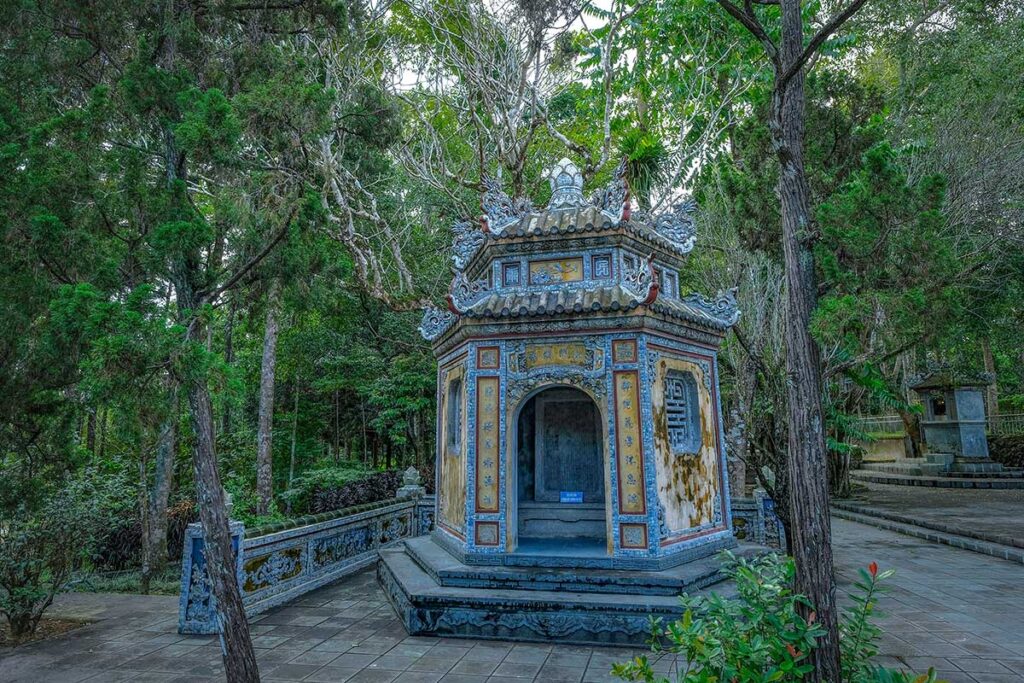
One of the most unique features of Tu Hieu Pagoda is its eunuch cemetery—a quiet area in the forest with weathered tombs and moss-covered stones. The eunuchs of the Nguyen court donated funds to support the temple in their later years and were buried here in return. This rare historical connection sets Tu Hieu apart from any other pagoda in Hue.
6. Bell Pavilion (Gác Chuông)

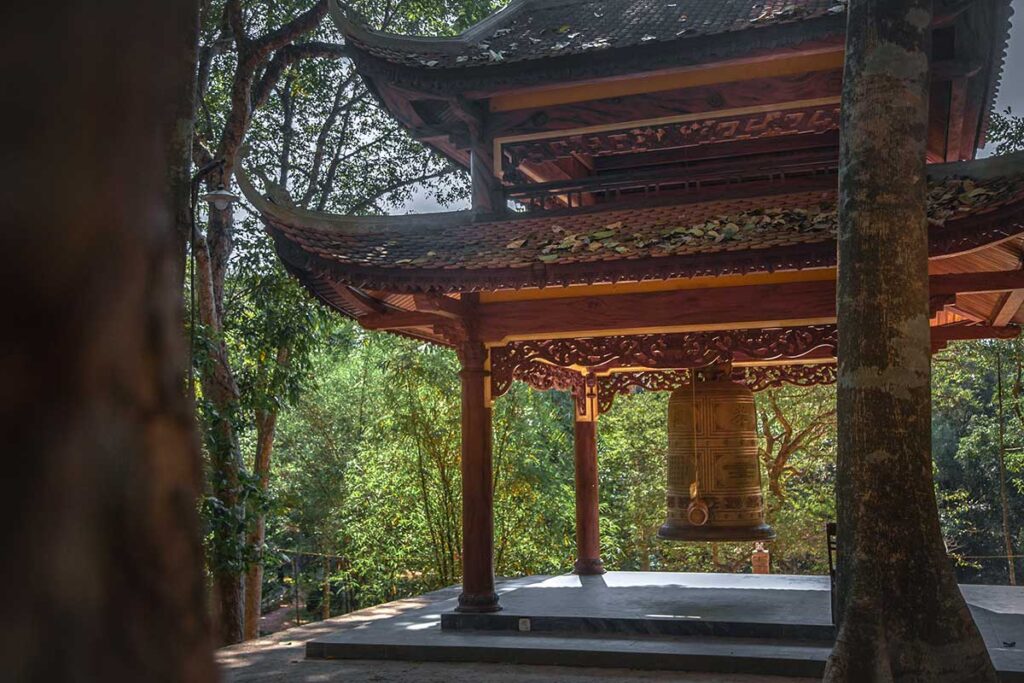
Tucked deeper into the forested grounds, Tu Hieu’s bell pavilion is an open-sided wooden structure housing a large bronze bell. Used during ceremonies and meditation, the bell’s resonant sound marks the rhythm of monastic life and adds to the temple’s quiet spiritual atmosphere. If you’re lucky, you may hear it ring softly through the pine trees, blending with the natural surroundings.
7. 8. Water Pavilion over the Pond
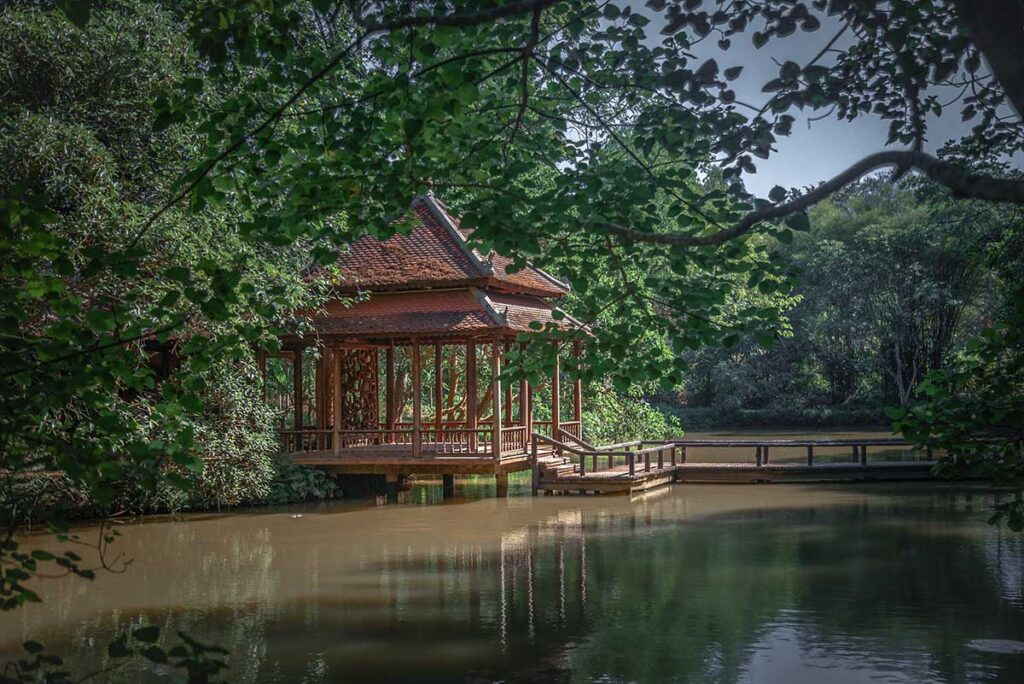
A little further into the pine grove you’ll find a half‑moon pond connected by a zigzag or wooden walkway leading to a fully open pavilion over the water. Designed for quiet reading or meditation, this “water pavilion” blends seamlessly into the landscape and reinforces the pagoda’s theme of stillness and reflection.
8. Monastic living quarters and meditation halls
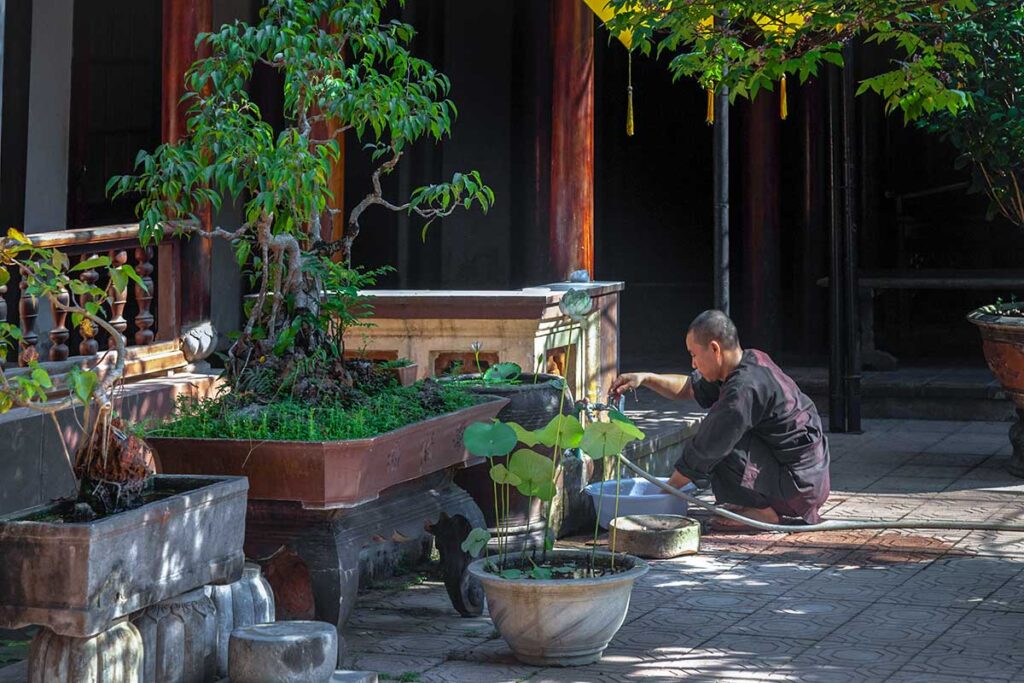
As an active monastery, Tu Hieu is home to a community of monks who live and practice here. While the residential areas are not open to visitors, you may catch glimpses of monks tending to the grounds, walking in meditation, or sitting quietly in the shade. Their presence adds to the pagoda’s peaceful rhythm and reminds visitors that this is still a living spiritual site.
Visiting information & travel tips
Location
Tu Hieu Pagoda is located in Thuy Xuan Ward, about 5 km southwest of Hue’s city center. It sits at the end of a small road in a peaceful pine forest, away from the busy streets—ideal if you’re looking for something quiet and local.
Opening hours
The pagoda is usually open from early morning until around 8:00 PM. There’s no official closing time posted, but mornings and late afternoons are the best times to visit.
Entrance fee
Entrance is free, and there’s no ticket booth. If you’d like, you can leave a small donation in the box near the main hall to help with upkeep.
Dress code
This is an active temple with monks living and practicing here, so it’s a good idea to dress respectfully. Cover your shoulders and knees, avoid flashy clothing, and keep your voice low while walking through the grounds.
Best times to bisit
- Early morning (6:00–8:00 AM): Quietest time of day, great light for photos, and you’ll likely see monks beginning their day.
- Late afternoon (around 4:00–6:00 PM): Cooler, calm, and a nice time for a relaxed walk under the pine trees.
Nearby places you can combine
Tu Hieu is close to a few other interesting stops:
- Tu Duc Tomb – Just about 1 km away, it’s one of the most elegant royal tombs in Hue.
- Vong Canh Hill – A small viewpoint nearby with nice views over the Perfume River. Great for a short stop, especially around sunset.
How to get to Tu Hieu Pagoda
Tu Hieu Pagoda is easy to reach from central Hue. Here are the most common ways to get there:
Taxi or Grab App
From the city center, a taxi or Grab car takes about 15 minutes and costs between 70,000–100,000 VND, depending on where you start. You can also book a GrabBike if you’re traveling solo and want a quicker ride. The pagoda is tucked into a quiet area, so it’s helpful to set the exact destination in the app.
Motorbike or bicycle
If you’re up for a bit of adventure, rent a motorbike or bicycle and ride through the back roads and villages toward the pagoda. The ride is flat and only takes about 20–25 minutes by bike. There’s a small parking area near the entrance where you can leave your vehicle.
Tip: The road to the pagoda is Le Ngo Cat Street. Keep going until the end—you’ll pass some small shops and forested areas, then see a sign pointing you to the temple.
Private car or tour
If you’re planning to visit several temples or tombs in one day, you can add Tu Hieu to a private car tour. It’s not included in most standard group tours, but most local drivers know the area well and can add it in if you ask.
